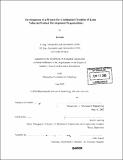| dc.contributor.advisor | Warren Seering. | en_US |
| dc.contributor.author | Kato, Jin | en_US |
| dc.contributor.other | Massachusetts Institute of Technology. Dept. of Mechanical Engineering. | en_US |
| dc.date.accessioned | 2006-03-29T18:36:36Z | |
| dc.date.available | 2006-03-29T18:36:36Z | |
| dc.date.copyright | 2005 | en_US |
| dc.date.issued | 2005 | en_US |
| dc.identifier.uri | http://hdl.handle.net/1721.1/32351 | |
| dc.description | Thesis (S.M.)--Massachusetts Institute of Technology, Dept. of Mechanical Engineering, 2005. | en_US |
| dc.description | Includes bibliographical references (p. 205-206). | en_US |
| dc.description.abstract | Ideas and methodologies of lean product development were developed into tools and processes that help product development organizations improve their performances. The definition of waste in product development processes was re-examined and developed into a frugal set to cover all types of waste in product development processes through preliminary case studies. Value stream mapping (VSM) was optimized for measuring the waste indicators in product development processes. Typical causes for low product development project performances were organized into a root-cause analysis diagram. Three case studies in product development companies were performed. The tools were tested and improved through intensive interviews with both project managers and engineers. VSM was effective for identifying and measuring waste indicators. The root-cause analysis diagram was effective for quickly identifying root causes for low product development project performances. Synchronized uses of these tools made it possible to measure each root cause's impact on project performances. The result of measurements revealed both problems shared by all the projects and the ones specific to the projects, indicating that the tools and processes developed in this research can provide suggestions for continuous improvement of product development processes. Some waste indicators were more prevalent than the others, implying that the number of waste indicators to be considered can be reduced. Inventory of information was prevalent in all the projects, and the analyses of it implied that Today's product development processes are as premature as those of manufacturing several decades ago. | en_US |
| dc.description.abstract | (cont.) Wastefulness of information inventory was proved quantitatively. Time spent on one occurrence of rework was proved to take longer near the end of a project than at the beginning of it. | en_US |
| dc.description.statementofresponsibility | by Jin Kato. | en_US |
| dc.format.extent | 206 p. | en_US |
| dc.format.extent | 9205622 bytes | |
| dc.format.extent | 9218596 bytes | |
| dc.format.mimetype | application/pdf | |
| dc.format.mimetype | application/pdf | |
| dc.language.iso | eng | en_US |
| dc.publisher | Massachusetts Institute of Technology | en_US |
| dc.rights | M.I.T. theses are protected by copyright. They may be viewed from this source for any purpose, but reproduction or distribution in any format is prohibited without written permission. See provided URL for inquiries about permission. | en_US |
| dc.rights.uri | http://dspace.mit.edu/handle/1721.1/7582 | |
| dc.subject | Mechanical Engineering. | en_US |
| dc.title | Development of a process for continuous creation of lean value in product development organizations | en_US |
| dc.type | Thesis | en_US |
| dc.description.degree | S.M. | en_US |
| dc.contributor.department | Massachusetts Institute of Technology. Department of Mechanical Engineering | |
| dc.identifier.oclc | 61493603 | en_US |
